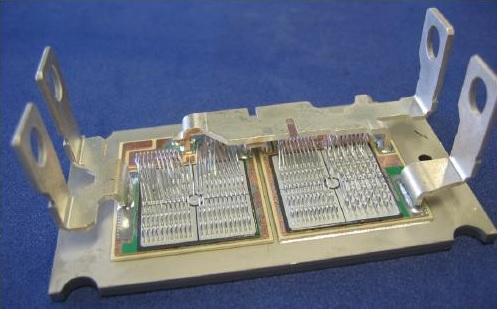The Evolution Of Power Module Packaging: Trends and Future Outlook
The Evolution Of Power Module Packaging: Trends and Future Outlook

Image source OpenPR.com
Power module packaging refers to the encapsulation or enclosure of electronic systems and elements used to manage and control power in different electronic applications. Technically, all electronic devices and systems have power modules. Each module should be packaged specially to ensure it functions perfectly as expected. Given the sensitivity of power in most systems, efficiency and performance are among the key reasons why packaging is an important factor to consider when buying power modules.
So, what is the history behind the power module packaging? Where are we in terms of the packaging technology? What is the future of power module packaging? Well, we are going to answer all these and many other questions that you might be having about power modules. If you are the type of person who is interested in electronics, it is important to know some key facts about power module packaging.
History of power module packaging
Where have we come from in terms of power module packaging? Well, there is a great history behind the evolution of power module packaging. To understand this, it is important to know what makes up a complete power module.
A typical power module comprises different electronic components. They include transistors, diodes, and resistors, among many others. Each of these components has a special role to play, especially when it comes to power-related functions.
During the very early days, when electronic technology was still new, power module packaging was a non-existent technology. All the components that make up a power module were packaged as single entities. Designers of electronic devices had to physically find space for the components and then place them. Once you picture this visually, you can easily tell how that mode of packaging was bulky and inefficient. They were also prone to overheating as the component placement did not prioritize heat management on the modules.
With time, compact power module packaging started replacing the initial packaging that was characterized by the disintegration of the components. In this form of packaging, several electronic components with similar physical and even electronic properties were bundled together to form a single module. This packaging offered a compact design and had better thermal management techniques than the initial power module packaging.
Some improvements in the electronic packaging technology resulted in the thick film packaging. In this method, manufacturers packaged electronic components on both thin and thick films. The final film provided stability for all the components of the power modules. It also made it easier to handle the modules as everything was packaged into a single package. Technicians would easily handle and connect the power modules to other of the components in a device.
Integrated circuits started gaining popularity in the 1990s and this had a direct impact on the packaging of the power modules. Manufacturers packaged their power modules in the form of integrated circuits. This means that the packaging modules had to conform to the structures and designs of IC chips. Compact and linear packaging options were developed.
The evolution of integrated circuits paved way for the surface mount technology (SMT) as a packaging option for power modules. This packaging technology has been in use from the 1990s to the present day. Most power modules in modern applications still use the SMT packaging method. In the SMT, all the electronic components that make up a power module are mounted directly onto the surface of a printed circuit board. This is the complete opposite of the through-hole technology, which is also a form of packaging that has been used in the electronics industry for ages.
One of the advantages of SMT packaging for power modules is it gives manufacturers the freedom to integrate different components into a single package. It also makes it easy to automate the power module manufacturing process. It also makes it easy to customize power modules to meet the needs of different applications. In other words, it offers maximum flexibility.
Surface mount technology paved the way for more advanced packaging methods that are used in modern electronics. Most of the modern methods were designed to match the needs of emerging technologies. This has been necessitated by the fact that electronic devices are increasingly becoming smaller while at the same time are expected to.
Thermal management and energy efficiency have emerged to be among the hottest topics in modern power module packaging. Advanced packaging solutions have been designed to handle these two issues. Direct copper bonding is one of the modern techniques that are used. Here, thick copper layers are bonded with ceramic isolators. The result is a substrate that can withstand high temperatures w without overheating. With such a packaging option, a device can easily sustain high operation temperatures without overheating.
Key considerations for the power module packaging
Several factors have greatly influenced the growth and evolution of power module packaging. They include the following:
Size
Since a power module is a physical object, size will always play a critical role in determining the packaging that is used. From the evolution, it is clear that the size of the power modules has been decreasing. The same applies to all the components that make up the modules. Manufacturers ensure that the packaging matches the size of the power module.
Thermal management
Heat management is a critical factor to consider when it comes to choosing power module packaging. The packaging should allow proper ventilation for maximum dissipation of heat. Manufacturers ensure that the package gives allowance for even distribution of heat. The coefficient of thermal expansion and thermal resistance are other critical heat-related parameters that must be considered when choosing the power module packaging. There should be minimal cases of overheating caused by the type of packaging that is used.
Electrical performance
The packaging that is used should not be a hindrance to the electrical performance of the power module. Instead, the module should be able to deliver better performance levels. Various electrical performance parameters such as current rating, power loss, switching frequency, and electromagnetic interference, among others. The packaging should take care of these parameters for a stable electrical performance.
Physical and mechanical strength
The power module packaging that you choose should be strong enough to protect the module from various physical forces. This is vital because some components of power modules are fragile and will easily break when mishandled. Excellent tensile strength will ensure that the module will withstand mechanical forces such as vibrations The peel strength, on the other hand, will ensure that the bodywork of the module remains in pristine condition.
Reliability
When we combine excellent performance with physical protection, the result is reliability. The packaging for the power module should be highly reliable. You should trust the packaging to deliver regardless of the external conditions. For instance, high temperatures and extreme mechanical movements should not affect the quality of the packaging used.
Power module packaging market trends and the future
As we have seen in the evolution of power module packaging, we are at the age where advanced packaging solutions are used on power modules. This has been witnessed in all the aspects of electronic industry. Since this is an evolving field of electronics, we should expect more advancements in the coming years.
Consumer electronics has witnessed the biggest transformation in power module packaging. This has been triggered by many factors, among them miniaturization of devices and demand for high-performance products. Furthermore, the spectrum for consumer electronics has expanded and covers a wider scope than before. The growth of IoT and smart devices are perfect examples of the revolution.
In terms of market performance, the power module packaging market size is estimated to be $2.5 billion in 2024. It is expected to hit $3.98 billion by 2029, a CAGR of 9.78. The transformation of power electronics is a key factor that is revolutionizing the power module packaging industry. Modern electronics are required to be more energy-conservative. Also, the automotive world is witnessing a shift to electric vehicles.
Conclusion
This article has given a comprehensive overview of the power module packaging. We have seen how this technology has evolved, the current trends, and the future of this technology. If you are building power module systems, the information that we have presented here gives you a clear picture of the industry. Are you planning to buy power modules? You will also use the information to know what you should look out for when it comes to the packaging that has been used. While at it, you should always look out for the emerging trends in the power module packaging and the expectations that you should have.
Working with the best distributors in the industry is the surest way of ensuring that you get the best deals when it comes to power module packaging. This is exactly what you stand to gain whenever you choose to work with Rantle East Electronic, a reputable distributor of power modules. We are experts in power modules and we also use deep experience in the industry to ensure that all our power modules feature the best packaging options. We are a company that you should consider working with in case you are planning to buy power modules for your applications.
Kevin Chen
Founder / Writer at Rantle East Electronic Trading Co.,Limited
I am Kevin Chen, I graduated from University of Electronic Science and Technology of China in 2000. I am an electrical and electronic engineer with 23 years of experience, in charge of writting content for ICRFQ. I am willing use my experiences to create reliable and necessary electronic information to help our readers. We welcome readers to engage with us on various topics related to electronics such as IC chips, Diode, Transistor, Module, Relay, opticalcoupler, Connectors etc. Please feel free to share your thoughts and questions on these subjects with us. We look forward to hearing from you!







 Start With
Start With Include With
Include With


